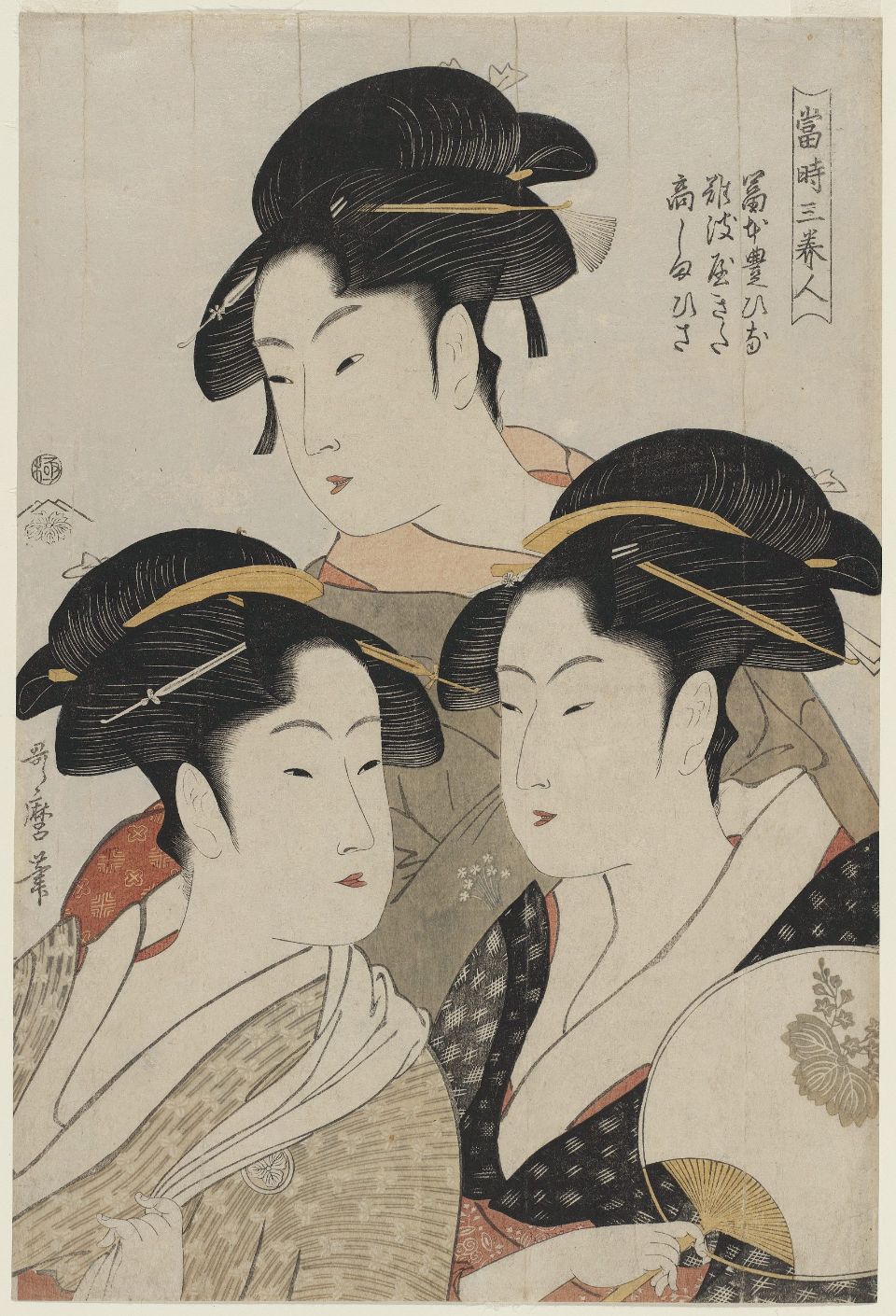Bijin-ga on:
[Wikipedia]
[Google]
[Amazon]
 is a generic term for pictures of beautiful women () in Japanese art, especially in woodblock printing of the ukiyo-e genre.
is a generic term for pictures of beautiful women () in Japanese art, especially in woodblock printing of the ukiyo-e genre.
File:Eisen1.jpg, by
File:Harunobu Bijin sur une véranda.JPG, Woman in the night, by Suzuki Harunobu,
File:Kiyonaga bathhouse women-2.jpg, Bathhouse women, by
Bijinga artworks
 is a generic term for pictures of beautiful women () in Japanese art, especially in woodblock printing of the ukiyo-e genre.
is a generic term for pictures of beautiful women () in Japanese art, especially in woodblock printing of the ukiyo-e genre.
Definition
defines as a picture that simply "emphasizes the beauty of women", and the ''Shincho Encyclopedia of World Art'' defines it as depiction of "the beauty of a woman's appearance". On the other hand, defines as pictures that explore "the inner beauty of women". For this reason, the essence of cannot always be expressed only through the depiction of a , a woman aligning with the beauty image. In fact, in ukiyo-e , it was not considered important that the picture resemble the facial features of the model, and the depiction of women in ukiyo-e is stylized rather than an attempt to create a realistic image; For example, throughout the Edo period (1603-1867), married women had a custom of shaving their eyebrows (), but in , there was a rule to draw the eyebrows for married women.History
Ukiyo-e itself is a genre of woodblock prints and paintings that was produced in Japan from the 17th century to the 19th century. The prints were very popular amongst the Japanese merchants and the middle class of the time. From the Edo period to the Meiji period (1868-1912), the technical evolution of ukiyo-e processes increased, with the accuracy of carving and printing and the vividness of colors used developing through the introduction of new printing processes and synthetic dyes. This technical development can also be seen in ukiyo-e , and many painters of contributed to the evolution of ukiyo-e techniques and styles, with the aim of mazimizing the realistic expression of a real beauty living in the artists' time period. Nearly all ukiyo-e artists produced , as it was one of the central themes of the genre. However, a few, includingUtamaro
Kitagawa Utamaro ( ja, 喜多川 歌麿; – 31 October 1806) was a Japanese artist. He is one of the most highly regarded designers of ukiyo-e woodblock prints and paintings, and is best known for his '' bijin ōkubi-e'' "large-heade ...
, Suzuki Harunobu, Itō Shinsui, Toyohara Chikanobu
, better known to his contemporaries as ,
was a Japanese painter and printmaker who was widely regarded as a prolific woodblock artist during the Meiji epoch.
Names
Chikanobu signed his artwork . This was his . The artist's was ; and it w ...
, Uemura Shōen
was the pseudonym of an artist in Meiji, Taishō and early Shōwa period Japanese painting. Her real name was Uemura Tsune. Shōen was known primarily for her ''bijin-ga,'' or paintings of beautiful women, in the ''nihonga'' style, although sh ...
and Torii Kiyonaga
Torii Kiyonaga ( ja, 鳥居 清長; 1752 – June 28, 1815) was a Japanese ukiyo-e artist of the Torii school. Originally Sekiguchi Shinsuke, the son of an Edo bookseller, from Motozaimokuchō Itchōme in Edo, he took on Torii Kiyonaga as a ...
, have been described as the greatest innovators and masters of the form.
Gallery
Keisai Eisen
Keisai Eisen (渓斎 英泉, 1790–1848) was a Japanese ''ukiyo-e'' artist who specialised in ''bijin-ga'' (pictures of beautiful women). His best works, including his ''ōkubi-e'' ("large head pictures"), are considered to be masterpieces of th ...
(1790–1848)
File:Suzuki Harunobu - Woman Visiting the Shrine in the Night - Google Art Project.jpg, ''Woman Visiting the Shrine in the Night'' by Suzuki Harunobu (1725–1770)
File:Yōshū Chikanobu Shin Bijin 12.jpg, series, No. 12 by Yōshū Chikanobu
, better known to his contemporaries as ,
was a Japanese painter and printmaker who was widely regarded as a prolific woodblock artist during the Meiji epoch.
Names
Chikanobu signed his artwork . This was his . The artist's was ; and it w ...
(1838–1912)
File:Yoshitoshi - 100 Aspects of the Moon - 11.jpg, ''100 Aspects of the Moon'' by Yoshitoshi
Tsukioka Yoshitoshi ( ja, 月岡 芳年; also named Taiso Yoshitoshi ; 30 April 1839 – 9 June 1892) was a Japanese printmaker.Louis-Frédéric, Nussbaum, Louis Frédéric. (2005)"Tsukoka Kōgyō"in ''Japan Encyclopedia,'' p. 10 ...
(1839–1892)
File:Brooklyn Museum - Two Women Standing from series "Tosai Yuri Bijin Awase" - Torii Kiyonaga.jpg, ''Two Women Standing'' from the series , by Torii Kiyonaga
Torii Kiyonaga ( ja, 鳥居 清長; 1752 – June 28, 1815) was a Japanese ukiyo-e artist of the Torii school. Originally Sekiguchi Shinsuke, the son of an Edo bookseller, from Motozaimokuchō Itchōme in Edo, he took on Torii Kiyonaga as a ...
(1752–1815)
File:Getsumei rinka bijin majiru.jpg, Woman with cherry flowers by Tsukioka Yoshitoshi
File:Brooklyn Museum - A Girl About to Despatch a Letter - Torii Kiyomine.jpg, ''A Girl About to Despatch a Letter'', by Torii Kiyomine (1786–1868)
File:Chokosai Eisho, The Courtesan Someyama of the Matsubaya Brothel, Matsubaya Someyama, Contest of Beauties in the Gay Quarters.jpg, ''The Courtesan Someyama of the Matsubaya house'', from the series ''Contest of Beauties in the Gay Quarters'', by Eishosai Choki (active from about 1786 to 1808)
File:Murasaki Shikibu 1876.jpg, '' Murasaki Shikibu'', from the series by Tsukioka Yoshitoshi (1839–1892)
Torii Kiyonaga
Torii Kiyonaga ( ja, 鳥居 清長; 1752 – June 28, 1815) was a Japanese ukiyo-e artist of the Torii school. Originally Sekiguchi Shinsuke, the son of an Edo bookseller, from Motozaimokuchō Itchōme in Edo, he took on Torii Kiyonaga as a ...
(1752–1815)
See also
* *Further reading
* *External links
Bijinga artworks
References
Japanese words and phrases Female beauty Ukiyo-e genres Women in art {{printmaking-stub